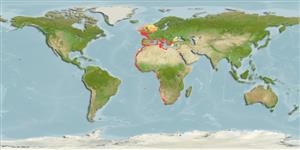Common names from other countries
分類 / Names
共通名の | 類義語 | Catalog of Fishes(部類, 種) | ITIS | CoL | WoRMS | Cloffa
Environment: milieu / climate zone / depth range / distribution range
生態学
海; 汽水性の 関連する礁; 深さの範囲 2 - 370 m (Ref. 4430). Subtropical; ? - 20°C (Ref. 10011); 60°N - 34°S, 19°W - 36°E (Ref. 114953)
Eastern Atlantic: northern UK (less common in southern North Sea and Kattegat) to Cape of Good Hope, South Africa. Also in the Mediterranean Sea.
Length at first maturity / サイズ / 重さ / 年齢
Maturity: Lm 44.0, range 39 - 49 cm
Max length : 100.0 cm TL オス/雌雄の選別がない; (Ref. 27000); common length : 60.0 cm TL オス/雌雄の選別がない; (Ref. 114953); 最大公表体重: 3.0 kg (Ref. 35388)
簡単な記述
検索表 | 形態学 | 形態計測学
背面の脊椎 (合計) : 0; 肛門の骨: 0; 脊つい: 104 - 108. Disc-width around the same as its length, length and width 1,50 to 1,70 times in total length; dorsal fins more or less rounded, its base 1,50 times in its height (Ref. 39215).
Occurs in seagrass areas, rocky reefs, and adjacent soft bottoms (Ref. 12951). Avoids temperatures above 20°C (Ref. 10011). Nocturnal, usually burying itself during the day with only the eyes and spiracle jutting out (Ref. 12382). Feeds on small benthic fishes Trachurus, Mugil, Mullus, Dicentrarchus, Spondyliosoma, Boops, Labrus, Dascyllus, Pomacentrus) and crustaceans (Ref. 10011). Females outlive males; viviparous, neonates measuring 10-14 cm at birth (Ref. 10426). Produces 2-32 pups in a litter after a 10-month gestation (Ref. 12951, Ref. 114953). Males reaches maturity at ca. 30 cm TL, females at ca. 40 cm TL; born at 10-14 cm TL (Ref. 114953). Electrocytes start developing when the embryo weighs about 1 g; electric organs functional before birth and newborns can use their electric organ discharge (EOD) in capturing prey (Ref. 10428). Can produce electric discharges of up to 200 volts; EOD frequency up to 600 Hz. Jumps on fast-moving prey, paralyzing it with its EOD (Ref. 27000).
Exhibit ovoviparity (aplacental viviparity), with embryos feeding initially on yolk, then receiving additional nourishment from the mother by indirect absorption of uterine fluid enriched with mucus, fat or protein through specialised structures (Ref. 50449).
Stehmann, M. and D.L. Bürkel, 1984. Torpedinidae. p. 159-162. In P.J.P. Whitehead, M.-L. Bauchot, J.-C. Hureau, J. Nielsen and E. Tortonese (eds.) Fishes of the north-eastern Atlantic and Mediterranean. UNESCO, Paris. Vol. 1. (Ref. 2803)
CITES (Ref. 128078)
Not Evaluated
Human uses
水産業: 興味がない; 水族館・水槽: 公共の水族館
用具
特記事項
XMLをダウンロードして下さい
インターネットの情報源
Estimates based on models
Preferred temperature (Ref.
115969): 10.1 - 19.2, mean 14.1 (based on 392 cells).
Phylogenetic diversity index (Ref.
82804): PD
50 = 0.5005 [Uniqueness, from 0.5 = low to 2.0 = high].
Bayesian length-weight: a=0.01820 (0.01478 - 0.02241), b=2.93 (2.87 - 2.99), in cm Total Length, based on LWR estimates for this species (Ref.
93245).
栄養段階 (Ref.
69278): 4.5 ±0.0 se; based on diet studies.
回復力 (Ref.
120179): 低い, 4.5年~14年の倍増期間の最小個体群 (Fec=5-32).
Fishing Vulnerability (Ref.
59153): High vulnerability (60 of 100).
